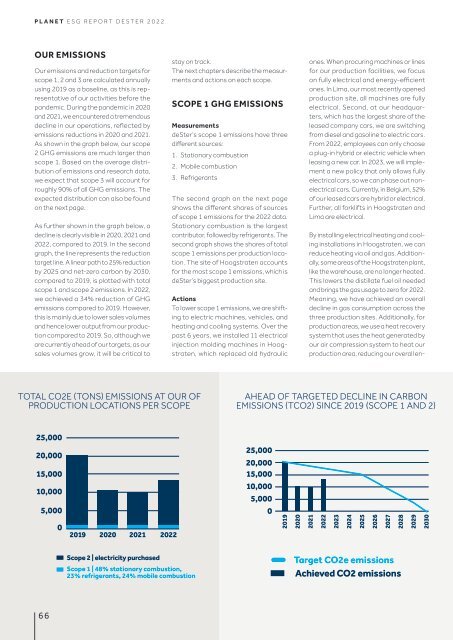deSter Sustainability Report 2022
deSter launched its first-ever Sustainability Report, showcasing deSter's dedication to environmental responsibility, social impact, and ethical governance, reflecting the company's holistic approach toward sustainability.
deSter launched its first-ever Sustainability Report, showcasing deSter's dedication to environmental responsibility, social impact, and ethical governance, reflecting the company's holistic approach toward sustainability.
Create successful ePaper yourself
Turn your PDF publications into a flip-book with our unique Google optimized e-Paper software.
PLANET ESG REPORT DESTER <strong>2022</strong><br />
OUR EMISSIONS<br />
Our emissions and reduction targets for<br />
scope 1, 2 and 3 are calculated annually<br />
using 2019 as a baseline, as this is representative<br />
of our activities before the<br />
pandemic. During the pandemic in 2020<br />
and 2021, we encountered a tremendous<br />
decline in our operations, reflected by<br />
emissions reductions in 2020 and 2021.<br />
As shown in the graph below, our scope<br />
2 GHG emissions are much larger than<br />
scope 1. Based on the average distribution<br />
of emissions and research data,<br />
we expect that scope 3 will account for<br />
roughly 90% of all GHG emissions. The<br />
expected distribution can also be found<br />
on the next page.<br />
As further shown in the graph below, a<br />
decline is clearly visible in 2020, 2021 and<br />
<strong>2022</strong>, compared to 2019. In the second<br />
graph, the line represents the reduction<br />
target line. A linear path to 25% reduction<br />
by 2025 and net-zero carbon by 2030,<br />
compared to 2019, is plotted with total<br />
scope 1 and scope 2 emissions. In <strong>2022</strong>,<br />
we achieved a 34% reduction of GHG<br />
emissions compared to 2019. However,<br />
this is mainly due to lower sales volumes<br />
and hence lower output from our production<br />
compared to 2019. So, although we<br />
are currently ahead of our targets, as our<br />
sales volumes grow, it will be critical to<br />
stay on track.<br />
The next chapters describe the measurments<br />
and actions on each scope.<br />
SCOPE 1 GHG EMISSIONS<br />
Measurements<br />
<strong>deSter</strong>’s scope 1 emissions have three<br />
different sources:<br />
1. Stationary combustion<br />
2. Mobile combustion<br />
3. Refrigerants<br />
The second graph on the next page<br />
shows the different shares of sources<br />
of scope 1 emissions for the <strong>2022</strong> data.<br />
Stationary combustion is the largest<br />
contributor, followed by refrigerants. The<br />
second graph shows the shares of total<br />
scope 1 emissions per production location.<br />
The site of Hoogstraten accounts<br />
for the most scope 1 emissions, which is<br />
<strong>deSter</strong>’s biggest production site.<br />
Actions<br />
To lower scope 1 emissions, we are shifting<br />
to electric machines, vehicles, and<br />
heating and cooling systems. Over the<br />
past 6 years, we installed 11 electrical<br />
injection molding machines in Hoogstraten,<br />
which replaced old hydraulic<br />
ones. When procuring machines or lines<br />
for our production facilities, we focus<br />
on fully electrical and energy-efficient<br />
ones. In Lima, our most recently opened<br />
production site, all machines are fully<br />
electrical. Second, at our headquarters,<br />
which has the largest share of the<br />
leased company cars, we are switching<br />
from diesel and gasoline to electric cars.<br />
From <strong>2022</strong>, employees can only choose<br />
a plug-in hybrid or electric vehicle when<br />
leasing a new car. In 2023, we will implement<br />
a new policy that only allows fully<br />
electrical cars, so we can phase out nonelectrical<br />
cars. Currently, in Belgium, 52%<br />
of our leased cars are hybrid or electrical.<br />
Further, all forklifts in Hoogstraten and<br />
Lima are electrical.<br />
By installing electrical heating and cooling<br />
installations in Hoogstraten, we can<br />
reduce heating via oil and gas. Additionally,<br />
some areas of the Hoogstraten plant,<br />
like the warehouse, are no longer heated.<br />
This lowers the distillate fuel oil needed<br />
and brings the gas usage to zero for <strong>2022</strong>.<br />
Meaning, we have achieved an overall<br />
decline in gas consumption across the<br />
three production sites. Additionally, for<br />
production areas, we use a heat recovery<br />
system that uses the heat generated by<br />
our air compression system to heat our<br />
production area, reducing our overall en-<br />
TOTAL CO2E (TONS) EMISSIONS AT OUR OF<br />
PRODUCTION LOCATIONS PER SCOPE<br />
AHEAD OF TARGETED DECLINE IN CARBON<br />
EMISSIONS (TCO2) SINCE 2019 (SCOPE 1 AND 2)<br />
25,000<br />
20,000<br />
15,000<br />
10,000<br />
5,000<br />
25,000<br />
20,000<br />
15,000<br />
10,000<br />
5,000<br />
0<br />
0<br />
Scope 2 | electricity purchased<br />
Scope 1 | 48% stationary combustion,<br />
23% refrigerants, 24% mobile combustion<br />
Target CO2e emissions<br />
Achieved CO2 emissions<br />
66


